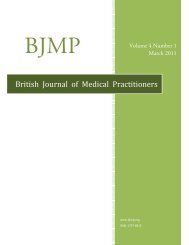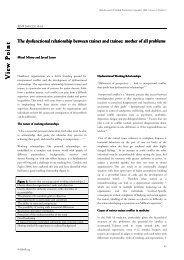R esearch A rticle - British Journal of Medical Practitioners
R esearch A rticle - British Journal of Medical Practitioners
R esearch A rticle - British Journal of Medical Practitioners
You also want an ePaper? Increase the reach of your titles
YUMPU automatically turns print PDFs into web optimized ePapers that Google loves.
<strong>British</strong> <strong>Journal</strong> <strong>of</strong> <strong>Medical</strong> <strong>Practitioners</strong>, March 2013, Volume 6, Number 1<br />
BJMP 2013;6(1):a609<br />
Editorial<br />
HBsAg carriers with normal ALT levels: Healthy carriers or true patients<br />
Claudio Puoti<br />
It is well documented that many HBsAg-positive / HBeAgnegative<br />
patients show normal alanine aminotransferase (ALT)<br />
levels. However, two different scenarios have been proven to<br />
exist: inactive Hepatitis B Virus (HBV) carriers (previously<br />
defined as “healthy” HBV carriers) and patients with chronic<br />
hepatitis B (CHB) with transient virological and biochemical<br />
remission. These subsets <strong>of</strong> patients share HBsAg positivity and<br />
normal ALT levels; however, progression <strong>of</strong> disease, outcome,<br />
HBV DNA levels, severity <strong>of</strong> liver damage, requirement for<br />
liver biopsy and antiviral treatment significantly differ between<br />
the two patient populations.<br />
Thus, among HBsAg-positive / HBeAg-negative subjects with<br />
normal liver biochemistry, it is important and sometimes<br />
difficult to distinguish the ‘true inactive HBV carriers’ from patients<br />
with ‘active CHB’ in whom phases <strong>of</strong> spontaneous remission have<br />
occurred. The former have a good prognosis with a low risk <strong>of</strong><br />
complications, while the latter patient population have active<br />
liver disease with a high risk <strong>of</strong> progression to liver cirrhosis<br />
and/or hepatocellular carcinoma (HCC). Therefore, prolonged<br />
biochemical and virological follow-up are mandatory for<br />
diagnosis and decision to treat.<br />
The term ‘chronic hepatitis B’ refers to a chronic necroinflammatory<br />
disease <strong>of</strong> the liver caused by persistent HBV infection 1 . The<br />
term ‘necroinflammatory’ describes the presence <strong>of</strong> death <strong>of</strong><br />
periportal hepatocytes (periportal necrosis) with or without<br />
disruption <strong>of</strong> the limiting plate by inflammatory cells,<br />
intralobular necrosis, portal or intralobular inflammation, and<br />
formation <strong>of</strong> bridges between vascular structures (the so-called<br />
bridging necrosis). Chronic hepatitis B can be subdivided into<br />
HbeAg positive and HBeAg-negative chronic hepatitis B 1,2 .<br />
These two forms may have different natural histories and<br />
different response rates to antiviral treatment, although both<br />
may progress to more severe liver damage 3 , such as, liver<br />
cirrhosis 4 or HCC 5 .<br />
The second subset is called the ‘inactive HBsAg carrier state’. It means a<br />
persistent HBV infection <strong>of</strong> the liver but without continual<br />
significant necroinflammatory disease. It is characterized by very<br />
low or undetectable serum HBV DNA levels and normal serum<br />
aminotransferases 1 . It has been shown that histologically<br />
significant liver damage is rare in these patients, particularly<br />
when HBV DNA is lower than 2000 IU/ml, and thus a liver<br />
biopsy is not indicated in these subjects 4 . Even among HBeAgnegative<br />
carriers with serum HBV DNA between 2000 and<br />
20,000 IU/ml, histologically significant liver disease is also<br />
rare 6 . Thus, these subjects should be followed up closely, but<br />
biopsy and treatment are not currently indicated.<br />
As mentioned above, it is sometimes difficult to distinguish true<br />
inactive HBV carriers from patients with active HBeAgnegative<br />
CHB in whom phases <strong>of</strong> spontaneous remission may<br />
have occurred 1 . The former patients have a good prognosis<br />
with a very low risk <strong>of</strong> complications, while the latter have<br />
active liver disease with a high risk <strong>of</strong> progression to advanced<br />
hepatic fibrosis, cirrhosis and subsequent complications such as<br />
decompensated cirrhosis and HCC 3-6 . Thus, a minimum<br />
follow-up <strong>of</strong> 1 year with ALT levels every 3–4 months and<br />
periodical measurements <strong>of</strong> serum HBV DNA levels are<br />
required before classifying a patient as an inactive HBV<br />
carrier 1 . ALT levels should remain consistently within the<br />
normal range, and HBV DNA should be below 2000 IU/ml 7 .<br />
Thereafter, the inactive HBV carrier with undetectable or very<br />
low HBV DNA levels should be followed up with ALT<br />
determinations every 6 months after the first year and periodical<br />
measurement <strong>of</strong> HBV DNA levels 6 for the rest <strong>of</strong> their lifetime.<br />
This follow-up policy usually allows detection <strong>of</strong> fluctuations <strong>of</strong><br />
activity in patients with true HBeAg-negative CHB 8 .<br />
It is important to underline that some inactive carriers may have<br />
HBV DNA levels greater than 2000 IU/ml (usually below<br />
20,000 IU/ml), despite their persistently normal ALT levels 1,6,9 .<br />
In these carriers the follow-up should be much more<br />
condensed, with ALT determinations every 3 months and HBV<br />
DNA measurements every 6–12 months for at least 3 years 1 .<br />
After these 3 years, these patients should be followed up for life<br />
like all inactive chronic HBV carriers 6 . After all, the inactive<br />
HBV carrier state confers a favourable long-term outcome with<br />
a very low risk <strong>of</strong> cirrhosis or HCC in the majority <strong>of</strong><br />
patients 1,10,11 . Patients with high baseline viremia levels have<br />
higher risk <strong>of</strong> subsequent reactivation. A liver biopsy should be<br />
recommended if ALT levels become abnormal and HBV DNA<br />
increases above 20,000 IU/ml. Non-invasive evaluation <strong>of</strong> liver<br />
fibrosis 12 may be useful, although these non-invasive tools, such<br />
as transient elastography, need further evaluation 6 .<br />
HBsAg clearance and seroconversion to anti-HBs antibody may<br />
occur spontaneously only in 1–3% <strong>of</strong> cases per year, usually<br />
after several years with persistently undetectable HBV DNA 7 .<br />
BJMP.org<br />
4







